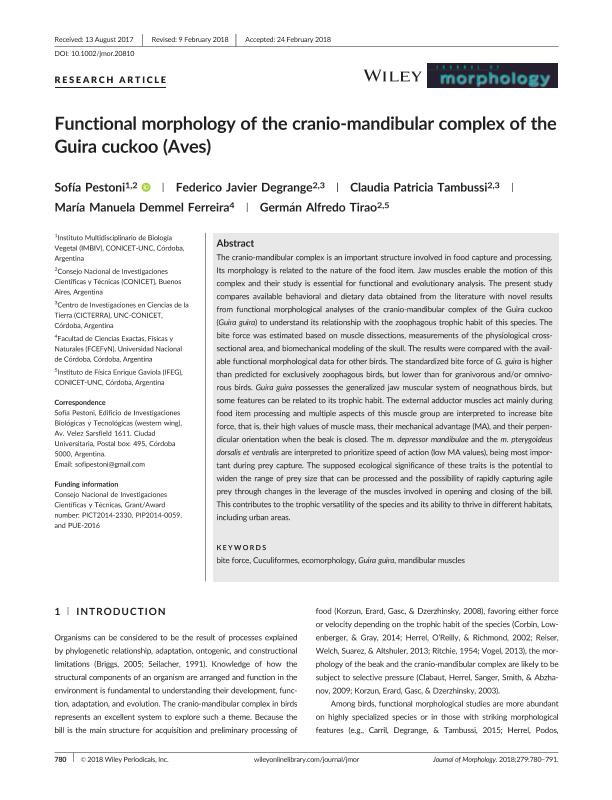Artículo
Functional morphology of the cranio-mandibular complex of the Guira cuckoo (Aves)
Pestoni, Sofía ; Degrange, Federico Javier
; Degrange, Federico Javier ; Tambussi, Claudia Patricia
; Tambussi, Claudia Patricia ; Demmel Ferreira, María Manuela
; Demmel Ferreira, María Manuela ; Tirao, German Alfredo
; Tirao, German Alfredo
 ; Degrange, Federico Javier
; Degrange, Federico Javier ; Tambussi, Claudia Patricia
; Tambussi, Claudia Patricia ; Demmel Ferreira, María Manuela
; Demmel Ferreira, María Manuela ; Tirao, German Alfredo
; Tirao, German Alfredo
Fecha de publicación:
06/2018
Editorial:
Wiley-liss, Div John Wiley & Sons Inc
Revista:
Journal of Morphology
ISSN:
0362-2525
e-ISSN:
1097-4687
Idioma:
Inglés
Tipo de recurso:
Artículo publicado
Clasificación temática:
Resumen
The cranio‐mandibular complex is an important structure involved in food capture and processing. Its morphology is related to the nature of the food item. Jaw muscles enable the motion of this complex and their study is essential for functional and evolutionary analysis. The present study compares available behavioral and dietary data obtained from the literature with novel results from functional morphological analyses of the cranio‐mandibular complex of the Guira cuckoo (Guira guira) to understand its relationship with the zoophagous trophic habit of this species. The bite force was estimated based on muscle dissections, measurements of the physiological cross‐sectional area, and biomechanical modeling of the skull. The results were compared with the available functional morphological data for other birds. The standardized bite force of G. guira is higher than predicted for exclusively zoophagous birds, but lower than for granivorous and/or omnivorous birds. Guira guira possesses the generalized jaw muscular system of neognathous birds, but some features can be related to its trophic habit. The external adductor muscles act mainly during food item processing and multiple aspects of this muscle group are interpreted to increase bite force, that is, their high values of muscle mass, their mechanical advantage (MA), and their perpendicular orientation when the beak is closed. The m. depressor mandibulae and the m. pterygoideus dorsalis et ventralis are interpreted to prioritize speed of action (low MA values), being most important during prey capture. The supposed ecological significance of these traits is the potential to widen the range of prey size that can be processed and the possibility of rapidly capturing agile prey through changes in the leverage of the muscles involved in opening and closing of the bill. This contributes to the trophic versatility of the species and its ability to thrive in different habitats, including urban areas.
Palabras clave:
BITE FORCE
,
CUCULIFORMES
,
ECOMORPHOLOGY
,
GUIRA GUIRA
,
MANDIBULAR MUSCLES
Archivos asociados
Licencia
Identificadores
Colecciones
Articulos(CICTERRA)
Articulos de CENTRO DE INVEST.EN CS.DE LA TIERRA
Articulos de CENTRO DE INVEST.EN CS.DE LA TIERRA
Articulos(IFEG)
Articulos de INST.DE FISICA ENRIQUE GAVIOLA
Articulos de INST.DE FISICA ENRIQUE GAVIOLA
Articulos(IMBIV)
Articulos de INST.MULTIDISCIPL.DE BIOLOGIA VEGETAL (P)
Articulos de INST.MULTIDISCIPL.DE BIOLOGIA VEGETAL (P)
Citación
Pestoni, Sofía; Degrange, Federico Javier; Tambussi, Claudia Patricia; Demmel Ferreira, María Manuela; Tirao, German Alfredo; Functional morphology of the cranio-mandibular complex of the Guira cuckoo (Aves); Wiley-liss, Div John Wiley & Sons Inc; Journal of Morphology; 279; 6; 6-2018; 780-791
Compartir
Altmétricas



